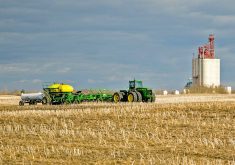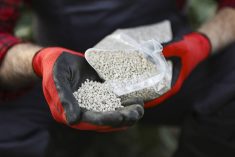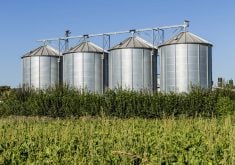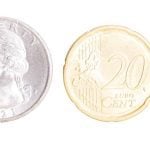If you’ve always assumed canola emerges poorly on eroded knolls because the soil there is poor, think again.
Toxicity from ammonium sulphate fertilizer could be the real reason behind those bald patches, especially on Newdale-type soils with high amounts of calcium carbonate in the subsoil zones, according to University of Manitoba student Laryssa Grenkow.
“The ammonium sulphate is reacting with the lime and increasing ammonium toxicity,” Grenkow said in a presentation at the recent CanoLABS event hosted by the Canola Council of Canada.
In her lab-based experiment, she compared canola seedling growth using various amounts of different fertilizer types in the seed row, ranging from phosphorus and sulphur at higher-than-recommended rates to ammonium sulphate anywhere from nine to 18 pounds per acre in pots filled with normal topsoil and also dirt from highly calcareous eroded knolls.
Read Also

Manitoba trials work toward drone spraying approvals
Canada’s PMRA says pesticides need drone-specific labels before drone spraying can take off; Manitoba crop trials are adding data towards that approvals process.
The rich, dark topsoil was about 0.5 per cent lime, while the whiter-looking eroded soil tested much higher at 21 per cent.
The phosphorus fertilizer didn’t affect emergence in either type of soil, but the ammonium sulphate wiped out almost all the plants that were sown into the pots containing the lime-rich, highly eroded soil.
The take-home message is that when seeding fields with lots of eroded knolls that have a high percentage of calcium carbonate, using ammonium sulphate as fertilizer is probably not a good idea, she said.
For farmers wondering how much fertilizer they can put in the seed row and still not cause damage to the canola stand, check out an online spreadsheet-based calculator offered by South Dakota State University, said John Heard, soil fertility specialist with Manitoba Agriculture, Food and Rural Initiatives. (Go to www.sdstate.edu and type ‘canola fertilizer spreadsheet’ in the search box.)
“Seed-placed fertilizer is usually a compromise between a bit of damage but a lot of fertility value. We just don’t want to tip that balance,” said Heard.
Users enter crop, fertilizer type, seed-fertilizer spread, row width, and the amount of stand reduction that you can live with.
“It then calculates the amount of fertilizer that will fulfil your wishes and gives you that stand reduction,” said Heard.














